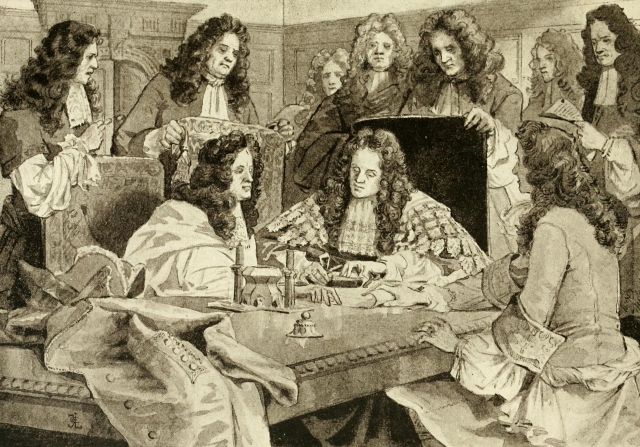There are few today who link banking with virtue. The common view is of an industry greedy for profits and far too willing to take risks that, when they go wrong, lead to expensive bail outs using tax-payers’ money while the perpetrators walk away with their bonuses intact.
The eighteenth-century view of financiers was often no better. The literature of the time was full of stories about greedy, manipulative monied men and, incidentally, hysterical and distinctly unvirtuous monied women. High finance was viewed with suspicion and speculative episodes, like the South Sea Bubble of 1720, provoked outrage, much as they do in the twenty-first century.
Nor was the Bank of England immune from such accusations. At this time, it was a private company answerable to its shareholders. It was still far from fully accepting the kind of responsibilities for support of the economy and banking system that characterise its work today. Although it served government interests, many of its critics thought it was seeking to extract too high a price for that service. And it had a reputation for aggressive defence of a monopoly that ensured that no other large banks could be established in London.
So why write a book about the Bank of England entitled ‘Virtuous Bankers’?
It’s certainly not because all the characters we meet were competent, moral and honest. Indeed, the Bank’s surviving records give us an insight into the kinds of people we might encounter in any office environment today, from the brilliant, up-and-coming Mr. Walsh, who was judged to be ‘very intelligent, very able’ to the supervisor, Mr. Vickery, whose management style was far more stick than carrot and who was loathed by his co-workers.
There were men like Mr. Gardiner who, having been with the Bank nearly 40 years, was ‘prejudiced to the old mode’ and thus unwilling to accept the pace of change required at a rapidly growing institution.
There were the men who drank on the job, those who were not terribly competent and those, like Mr. Bridges whose ‘chattering’ made them unfit for public-facing positions. There were clerks whose proximity to the financial market meant they spent as much time acting as brokers and stockjobbers as performing their roles.
This was against the Bank’s rules as it was felt to hold out ‘powerful temptations… to Men, not in affluent circumstances’. Indeed, there were those for whom the temptation of access to the accounts of the Bank’s customers proved to be too much. This included Francis Fonton who funded a mistress and thoroughly dissolute lifestyle by embezzling funds. It was his job as a stock transfer clerk that gave him the skills and access needed for this duplicity.
The fact that there were relatively few men who chose this path was probably due less to the Bank’s systems of management and more to the punishment inflicted on those who were caught—the unfortunate Mr. Fonton went to the gallows.
Yet, despite clerks who were incompetent, immoral or downright criminal, the men who worked for the Bank during the eighteenth-century were proud of their roles. Being a Bank of England clerk was a sought-after position and one in which men stayed for many years working long into their old age, despite the generous pensions offered by their employer.
They were also proud of their contribution, often referencing their duty to the public and the importance of their service. There is very clear evidence also that the public recognised and appreciated that service and regarded the Bank of England as the guardian of public credit. They knew their funds were safe within the Bank’s walls and that the institution would act in their interests.
The institution’s directors carefully curated an image of virtue. By the mid-eighteenth century the Bank’s building was considered to be one of the most impressive in London and it displayed a certain character: solid, secure and flourishing. The Bank’s symbol, Britannia, was repeated throughout the building and stamped on its notes, letterheads and ledgers. With her shield and spear and close associations with trade, industry and profit, Britannia offered a clear statement of the conflation of the Bank’s aims with the goals of the British state.
These outward displays of virtue were reflected in the views of the men who ran the Bank. They had no hesitation in speaking of their institution as a place of ‘immense importance…not only to the City of London, in points highly essential to the promotion & extension of its Commerce, but to the Nation at large’. And they were right in these assumptions. The Bank at this time managed two-thirds of the public debt, supported the work of the Exchequer and was the primary discounter of bills of exchange, thus keeping the wheels of the economy well greased, when it saw fit, of course.
Taking into account all the Bank did—its lapses, failures and risks, along with its capacity for innovation and ability to manage vast amounts of wealth—a report in 1783 came to a clear conclusion: the Bank should ‘necessarily excite care and solicitude in every breast’. There was no question in the minds of its directors that their institution was virtuous and that the British public should show ‘a religious Veneration for [its] glorious fabric [and give] ‘steady and unremitting attention to its sacred Preservation’.
Anne L. Murphy is professor of history and executive dean of the Faculty of Humanities and Social Sciences at the University of Portsmouth. Before joining academia, she worked for twelve years in the City of London trading interest rate and foreign exchange derivatives. She is the author of The Origins of the English Financial Markets.

